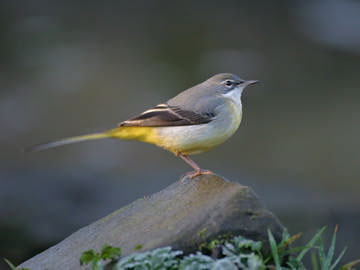
Grey Wagtail © Steve Round
In winter, most Grey Wagtails quit their upland and northern areas to move into the English lowlands. Many Scottish birds move to England for the winter, and a few come here from continental Europe (Migration Atlas). In Cheshire and Wirral, some stay on their breeding territories while others spread out into a wider range of habitats, not necessarily associated with water. Sewage works, farmyards, slurry pits, canal towpaths and gardens all attract them, and they are a common wintering bird in urban areas. Individuals often seem faithful to particular sites, within a season and from year to year, as Coward (1910) had noted.
The submitted winter habitat codes showed that Grey Wagtails have much less attachment to water (47% of the total, down from 76% in the breeding season), with 22% human sites and 27% on farmland of all types. Observers noted them feeding in slurried fields and in flooded parts of stubble, even in the normally sterile maize fields. They take a wide variety of food: flies, worms and midge larvae when they can find them, small fish and even household scraps.
A century ago, Grey Wagtails left their breeding areas in autumn … ‘the birds descend to the Plain, and from October to March are distributed over the lowlands, where they haunt the meres and smaller streams. In the west, the bird is seldom seen, even in winter. Brockholes (1874) observed it only occasionally in Wirral.’ (Coward and Oldham 1900). Boyd (1951) described the bird as a winter resident in mid-Cheshire, appearing in October by Marbury Mere and in wet ditches and remaining, often throughout the coldest weather, until March. As now, they were noted visiting farmyard middens and gardens. Bell (1962) echoed these comments, writing that in the autumn the hill streams are deserted and as a winter resident the bird is fairly common along the river valleys and meresides on the plain, returning to the hills between February and April depending on the season.
In this Atlas they were found in 414 tetrads in winter, almost twice as many as in the breeding season. Only 60 of their breeding tetrads were unoccupied in winter, including 11 of those over 250m in altitude. They are widespread in Wirral and west Cheshire, in areas where they do not breed. It is likely that they would be more restricted in range in hard weather, and the county bird reports over the years link the species’ numbers with cold winters. There was no difference between the three years of this Atlas survey, with 211, 201, and 211 tetrads with records: the total numbers counted were incredibly stable at 250, 248 and 252 in the three winters.
Ten birds were seen in one group with 8 Pied Wagtails in 2004/ 05 at Maw Green (SJ75D), and two flocks of six birds were reported elsewhere, but almost three-quarters of counts submitted were of single birds. Grey Wagtails sometimes join Pied Wagtails in their communal roosts, or form a single-species gathering on their own, usually in small numbers. Up to 40 were reported in 1993/ 94 in a tree growing out of a wall at The Groves, Chester, and a maximum of 17 at Poynton Pool in winter 1995/ 96. The regular autumn roost at Arclid SQ from 1985 to 2003 sometimes held a dozen or more birds into the start of the winter period, and occasionally lasted through the winter, with up to ten birds in 1989/ 90 and eight in 1992/ 93. There were, however, no roosting birds reported anywhere in this survey.
Sponsored by Astra Zeneca, Club AZ Natural History section

